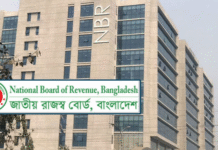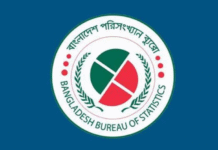The huge number of workers leaving Bangladesh for overseas job does not match with the remittance they send as most of them are unskilled and thus fall far behind the skilled workers sent by other countries.
Bangladesh still lags behind the Philippines, Sri Lanka, Pakistan and India in terms of both sending skilled workers abroad and earning remittance.
The World Bank’s migration and remittances fact book 2016 shows that among the top 10 remittance receiving countries in the world, Bangladesh was the 10th with remittance worth $15.8 billion in 2015 while India earned the highest $72.2 billion, the Philippines stood third with remittance worth $29.9 billion and Pakistan was the 8th with $20.1 billion in remittance.
Of the stock of emigrants, WB data shows that there are 13.9 millions of Indians while 7.6 millions of Bangladeshis, 6.2 millions of Pakistanis and 6 millions of Pilipino.
Officials of expatriate welfare and overseas employment ministry have admitted that Bangladesh has been branded a source of unskilled workers and foreign employers are often reluctant to recruit even the skilled workers from here.
Besides, the local recruiting agencies are more interested in sending unskilled workers so that they can do brisk business by charging them high, they told New Age.
The officials also cite non-recognition of workers’ skills certificate, issued from local technical training centres, by the foreign employers as another cause of sending so many unskilled workers.
According to Bureau of Manpower, Employment and Training, only 32 per cent of Bangladeshi workers have gone abroad as skilled workers since 1976.
BMET director for immigration Atiqur Rahman told New Age that migration of the skilled workers from Bangladesh increased to 42 per cent in 2016.
He admitted that most of the workers going abroad were under unskilled category, working hard but earning much less than the skilled workers.
UN Department of Economic and Social Affairs shows the world migration in figures in 2010-11 that some 7.4 per cent of the total Pilipino emigrants were highly educated.
The highly educated emigrants from Sri Lanka account for 5.7 per cent while 5.5 per cent from Pakistan and 3.2 per cent from India and Bangladesh each in the corresponding year.
The returned workers and officials concerned say that a Bangladeshi unskilled worker gets monthly US$ 220 to US$ 250 in the Middle East or East Asian countries where a skilled worker with skills certificate from Sri Lanka, India and Philippines get double the wage — US$ 450 to US$ 500.
Mobarak Hossain, a returnee from Saudi Arabia, said that there was a huge demand for electricians, drivers, and filling station operators, feeding supervisors, health technicians, cooling technicians, machine technicians and welders in the kingdom.
He found that mostly Indians, Sri Lankans
and the Filipinos were recruited for those jobs in the country.
Mobarak, who worked as a filling station operator at National Agricultural Development Company in Saudi Arabia, said that only unskilled workers from Bangladesh were sent to the kingdom and they earn half of what the skilled workers from India, Philippines and Sri Lanka get.
Similar views were expressed by Moradul Haq Shohag, who returned from the United Arab Emirates after serving Dubai-based Power Group of Company for 12 years.
He said that construction labourers in the UAE were mostly from Bangladesh while their supervisors were from India.
WARBE Development Foundation general secretary Faruque Ahmed said that despite the huge demand for skilled workers abroad, the recruiting agencies preferred to send unskilled workers as they could be charged high and cheated easily by the recruiters.
Faruque, who himself worked in Saudi Arabia, observed that the Bangladesh government preferred counting the number of migrants to maintaining their quality.
Ovibashi Karmi Unnyan Programme chairman Shakirul Islam said that the government did not yet take any step to groom trade-specific skilled workers considering the requirement of the recipient countries.
For this, he said, Bangladeshis were still lagging behind the Pilipino, the Indians and the Sri Lankans who mostly held the posts of skilled workers at the destination countries.
Additional secretary to EWOE ministry Jabed Ahmed told New Age that Bangladesh was sending more unskilled workers abroad as the country was getting less demand of skilled workers from the overseas countries.
He also said that the country’s recruiting agencies do not recruit skilled workers who have completed training courses from the TTCs.
Jabed admitted that the exiting problem regarding the recognition of the skills certificates abroad was another reason behind sending less skilled workers.
He, however, claimed that the government was working to groom skilled workers for overseas jobs and working with TEFE Australia and City and Guilds of the UK to get global recognition of the TTC certificates.
Bangladesh still lags behind the Philippines, Sri Lanka, Pakistan and India in terms of both sending skilled workers abroad and earning remittance.
The World Bank’s migration and remittances fact book 2016 shows that among the top 10 remittance receiving countries in the world, Bangladesh was the 10th with remittance worth $15.8 billion in 2015 while India earned the highest $72.2 billion, the Philippines stood third with remittance worth $29.9 billion and Pakistan was the 8th with $20.1 billion in remittance.
Of the stock of emigrants, WB data shows that there are 13.9 millions of Indians while 7.6 millions of Bangladeshis, 6.2 millions of Pakistanis and 6 millions of Pilipino.
Officials of expatriate welfare and overseas employment ministry have admitted that Bangladesh has been branded a source of unskilled workers and foreign employers are often reluctant to recruit even the skilled workers from here.
Besides, the local recruiting agencies are more interested in sending unskilled workers so that they can do brisk business by charging them high, they told New Age.
The officials also cite non-recognition of workers’ skills certificate, issued from local technical training centres, by the foreign employers as another cause of sending so many unskilled workers.
According to Bureau of Manpower, Employment and Training, only 32 per cent of Bangladeshi workers have gone abroad as skilled workers since 1976.
BMET director for immigration Atiqur Rahman told New Age that migration of the skilled workers from Bangladesh increased to 42 per cent in 2016.
He admitted that most of the workers going abroad were under unskilled category, working hard but earning much less than the skilled workers.
UN Department of Economic and Social Affairs shows the world migration in figures in 2010-11 that some 7.4 per cent of the total Pilipino emigrants were highly educated.
The highly educated emigrants from Sri Lanka account for 5.7 per cent while 5.5 per cent from Pakistan and 3.2 per cent from India and Bangladesh each in the corresponding year.
The returned workers and officials concerned say that a Bangladeshi unskilled worker gets monthly US$ 220 to US$ 250 in the Middle East or East Asian countries where a skilled worker with skills certificate from Sri Lanka, India and Philippines get double the wage — US$ 450 to US$ 500.
Mobarak Hossain, a returnee from Saudi Arabia, said that there was a huge demand for electricians, drivers, and filling station operators, feeding supervisors, health technicians, cooling technicians, machine technicians and welders in the kingdom.
He found that mostly Indians, Sri Lankans
and the Filipinos were recruited for those jobs in the country.
Mobarak, who worked as a filling station operator at National Agricultural Development Company in Saudi Arabia, said that only unskilled workers from Bangladesh were sent to the kingdom and they earn half of what the skilled workers from India, Philippines and Sri Lanka get.
Similar views were expressed by Moradul Haq Shohag, who returned from the United Arab Emirates after serving Dubai-based Power Group of Company for 12 years.
He said that construction labourers in the UAE were mostly from Bangladesh while their supervisors were from India.
WARBE Development Foundation general secretary Faruque Ahmed said that despite the huge demand for skilled workers abroad, the recruiting agencies preferred to send unskilled workers as they could be charged high and cheated easily by the recruiters.
Faruque, who himself worked in Saudi Arabia, observed that the Bangladesh government preferred counting the number of migrants to maintaining their quality.
Ovibashi Karmi Unnyan Programme chairman Shakirul Islam said that the government did not yet take any step to groom trade-specific skilled workers considering the requirement of the recipient countries.
For this, he said, Bangladeshis were still lagging behind the Pilipino, the Indians and the Sri Lankans who mostly held the posts of skilled workers at the destination countries.
Additional secretary to EWOE ministry Jabed Ahmed told New Age that Bangladesh was sending more unskilled workers abroad as the country was getting less demand of skilled workers from the overseas countries.
He also said that the country’s recruiting agencies do not recruit skilled workers who have completed training courses from the TTCs.
Jabed admitted that the exiting problem regarding the recognition of the skills certificates abroad was another reason behind sending less skilled workers.
He, however, claimed that the government was working to groom skilled workers for overseas jobs and working with TEFE Australia and City and Guilds of the UK to get global recognition of the TTC certificates.
Source: New Age










